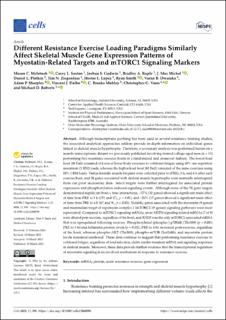| dc.description.abstract | Although transcriptome profiling has been used in several resistance training studies, the associated analytical approaches seldom provide in-depth information on individual genes linked to skeletal muscle hypertrophy. Therefore, a secondary analysis was performed herein on a muscle transcriptomic dataset we previously published involving trained college-aged men (n = 11) performing two resistance exercise bouts in a randomized and crossover fashion. The lower-load bout (30 Fail) consisted of 8 sets of lower body exercises to volitional fatigue using 30% one-repetition maximum (1 RM) loads, whereas the higher-load bout (80 Fail) consisted of the same exercises using 80% 1 RM loads. Vastus lateralis muscle biopsies were collected prior to (PRE), 3 h, and 6 h after each exercise bout, and 58 genes associated with skeletal muscle hypertrophy were manually interrogated from our prior microarray data. Select targets were further interrogated for associated protein expression and phosphorylation induced-signaling events. Although none of the 58 gene targets demonstrated significant bout x time interactions, ~57% (32 genes) showed a significant main effect of time from PRE to 3 h (15↑ and 17↓, p < 0.01), and ~26% (17 genes) showed a significant main effect of time from PRE to 6 h (8↑ and 9↓, p < 0.01). Notably, genes associated with the myostatin (9 genes) and mammalian target of rapamycin complex 1 (mTORC1) (9 genes) signaling pathways were most represented. Compared to mTORC1 signaling mRNAs, more MSTN signaling-related mRNAs (7 of 9) were altered post-exercise, regardless of the bout, and RHEB was the only mTORC1-associated mRNA that was upregulated following exercise. Phosphorylated (phospho-) p70S6K (Thr389) (p = 0.001; PRE to 3 h) and follistatin protein levels (p = 0.021; PRE to 6 h) increased post-exercise, regardless of the bout, whereas phospho-AKT (Thr389), phospho-mTOR (Ser2448), and myostatin protein levels remained unaltered. These data continue to suggest that performing resistance exercise to volitional fatigue, regardless of load selection, elicits similar transient mRNA and signaling responses in skeletal muscle. Moreover, these data provide further evidence that the transcriptional regulation of myostatin signaling is an involved mechanism in response to resistance exercise. | en_US |
